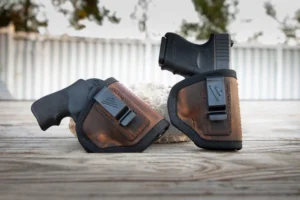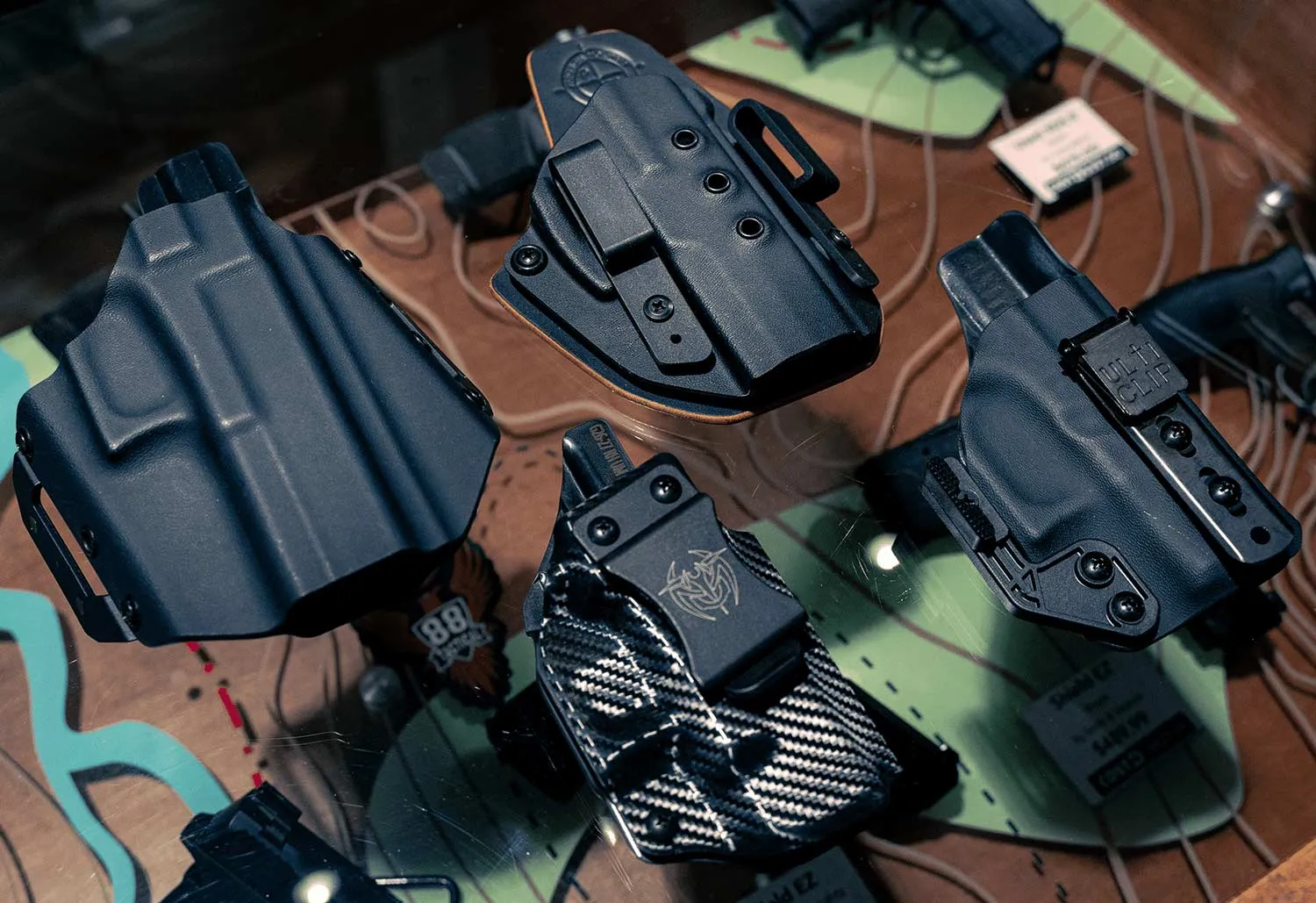There are many different types of holsters and methods of carrying concealed. The number of options and considerations can be overwhelming if you don’t know where to start. Each holster has its strengths and limitations. Your body type, daily activities, and clothing choices will dictate what will work best and which holster to choose.
Do I need a holster to conceal carry?
In most states, no specific laws require an individual who is legally permitted to carry a concealed firearm to use a holster. However, some states do have requirements for how a firearm is carried, such as requiring the use of a holster that covers the trigger guard. Additionally, even in states without such requirements, it is generally recommended that individuals use a holster to safely and securely carry their firearms. Carrying a firearm without a holster can increase the risk of accidents, such as an unintentional discharge, and can also make it difficult to quickly access the firearm if needed. Therefore, while not required by law, it is highly advisable to use a holster when carrying a concealed firearm in the United States.
8 Factors to Consider when Choosing a Concealed Carry Holster
Your holster must:
- Always cover the trigger and trigger guard. It would be dangerous to go about your daily activities with your trigger constantly exposed, so it’s important that your holster properly protects your trigger. An exposed trigger could easily be bumped or snagged, causing a negligent discharge, which could very well result in serious injury.
- Hold your gun securely. It’s important to buy a holster that’s molded for your exact firearm to ensure proper retention. As silly as it sounds, you don’t want your gun to fall out of your holster when you bend over because the holster is too loose or have trouble retrieving your gun from the holster because it’s too tight.
- Hold securely to your body. It’s extremely important to have the correct attachment Quality attachments can also make a big difference in how well your gun conceals.
- Aid in concealing the firearm. Some holsters are easier to conceal than others. Inside-the-waistband (IWB) holsters cling closer to the body, which aids concealment. Outside-the-waistband (OWN) holsters are not practical for year-round Typically, the only time you can get away with an OWB holster is if you are wearing a sweatshirt and/or jacket.
- Allow a consistent good grip and draw. If your gun sits too low in the holster, it will be extremely difficult to get a consistent grip and draw as the gun will not be exposed enough. If the gun isn’t held tight in the holster, your grip and draw won’t be consistent either.
- Allow your gun to return to the holster safely. You should be able to get your gun in your holster without snagging, catching, or flagging yourself. This issue is most common with holsters made of soft, flexible material.
- Be comfortable and durable. The most important part here is durability. A holster that breaks down and loses its shape can be potentially dangerous.
- Do all these things during vigorous activity. If you must run, hide, or fight, you want to know your gun is securely in your holster and that the holster is secure to your body.
 Different Types of Concealed Carry Holster Materials
Different Types of Concealed Carry Holster Materials
There are a few main types of materials when it comes to holsters. Each option comes with a list of pros and cons. As long as your holster does the 8 things listed above, the “right” choice for you comes down to your preferences and lifestyle.
Leather
Leather is the oldest holster material. It’s fairly comfortable, but you do have to worry about it breaking down over time and becoming a potential safety hazard. The opening of leather holsters can eventually become warped, which will be problematic when holstering your firearm. The edges could potentially fold into your trigger guard and cause a negligent discharge. The retention of leather holsters can also be hit or miss. The retention may start great, but over time with use, the leather can eventually stretch. Some will have straps to keep the firearm held in place; these straps pose a set of different obstacles. For example, if you are trying to quickly get your firearm out of the holster while under stress, the straps will get in the way, and when trying to re-holster the firearm, the straps could also get in the way of putting your gun away safely.
Depending on how stiff the leather is, the opening may collapse when you pull your gun out of the holster if it’s inside the waistband. When this happens, people end up muzzling themselves with the gun, whether they use their support hand to hold the opening or use the muzzle of the gun to dig for the opening.
Kydex
Kydex is a tough plastic material. It’s heat-molded to fit firearms precisely, which is why they are known for having great retention. Some will even allow the retention to be adjusted. Kydex is one of the most durable but least comfortable holster materials. Kydex doesn’t degrade or break down over time, and it never loses its rigidity. The opening won’t collapse when you take your gun out of the holster if it’s inside the waistband. It’s a relatively inexpensive material, and many manufacturers will have a lifetime warranty on their products. Kydex is also very customizable – the material comes in nearly any color or pattern, and they are compatible with many different types of attachment pieces.
Nylon
Nylon is one of the most comfortable but one of the least durable holster materials. Due to its soft nature, most nylon holsters are extremely inconsistent. Nylon holsters typically have poor retention. Like some leather holsters, many nylon-style holsters will require straps to keep the gun secure. They do not allow for a good consistent grip and draw because of how the gun sits in the holster. Most often, it sits too deep. IWB Nylon holsters are also prone to collapse once the gun is removed.
Hybrid
Hybrid holsters will come in either a Kydex/leather combination or a Kydex/nylon combination. They have improved comfort over a standard Kydex holster, but some of the durability and good retention of a Kydex holster (depending on the brand you choose). With leather, it’s still important to be wary of the potential for breakdown. With nylon, make sure it’s not too soft so it doesn’t fold over when reholstering your firearm.
3 Types of Holster Attachments
There are many ways to secure a holster to your person, but we’re only going to touch on the three most popular types of holster attachments.
Clips and loops
These are two of the best options when it comes to IWB concealment due to how secure they are. Clips are primarily intended for IWB holsters, but some can still be worn outside the waistband too. Certain clips will allow you to adjust the cant of your holster (the “cant” refers to the tilt or angle of your gun when it’s sitting in the holster).
Slots
Slots are the most secure attachment but not the best option for concealment because you will only see them on an OWB holster.
Paddles
Like slots, paddles are only found on an OWB-style holster, which, again, is not ideal for concealed carry. The security of paddle attachments can be hit or miss.
If you still aren’t sure which holster option is best for you, please stop by our Pro Shop and chat with one of our Retail Associates.
Concealed Carry Training
88 Tactical offers the most comprehensive Concealed Carry course in the state. In addition to the state-required material, students take part in reality-based defensive drills and are taught concepts of mindset and the realities of self-defense. The class consists of lectures, demonstrations, dry-fire practice, and live-fire training and testing.
*If you are not comfortable going to the range and shooting on your own, we highly recommend that you take our Intro to Handgun Course first.


